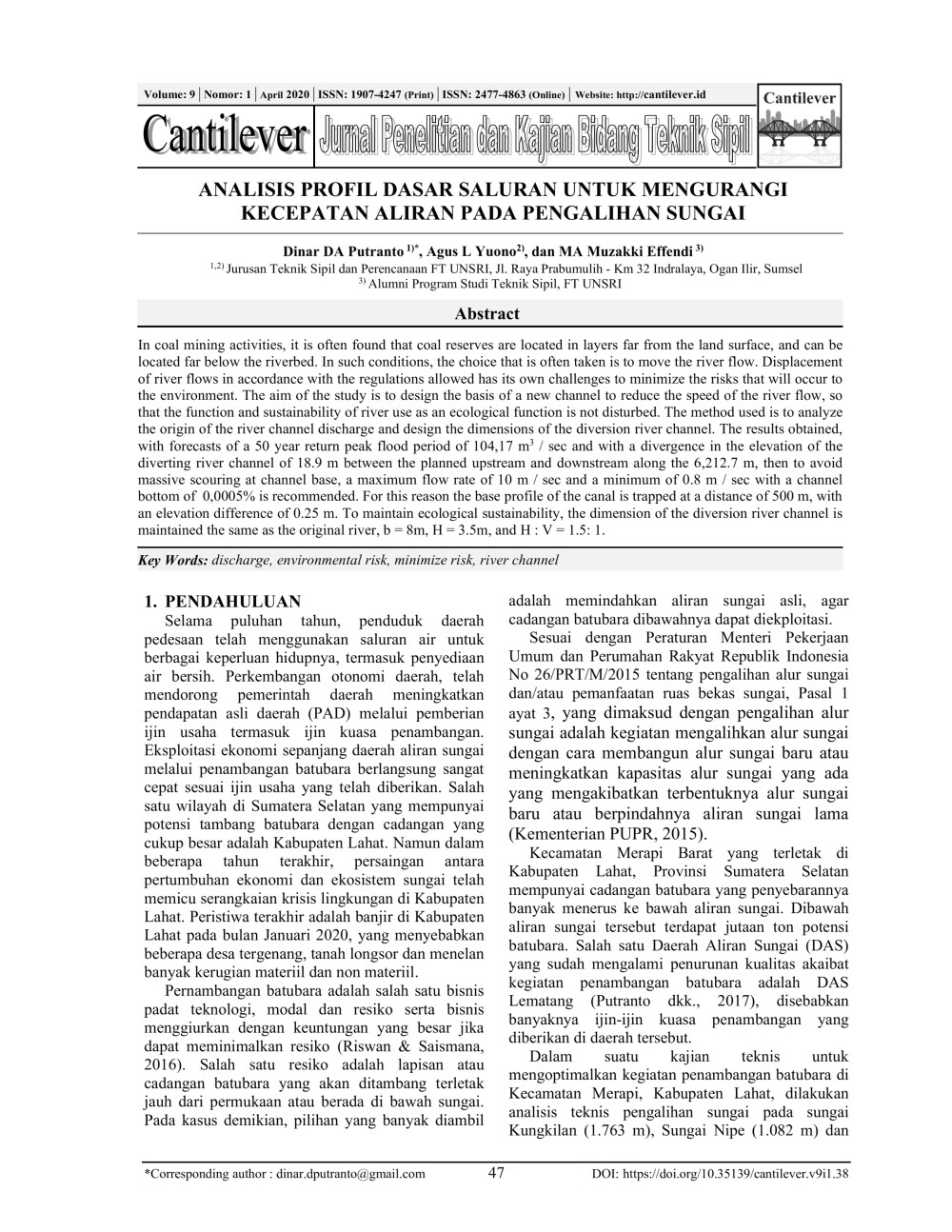Analisis Profil Dasar Saluran Untuk Mengurangi Kecepatan Aliran Pada Pengalihan Sungai Bed Channel Profile Analysis to Reduce Flow Velocity in River Diversion
Main Article Content
Abstract
In coal mining activities, it is often found that coal reserves are located in layers far from the land surface, and can be located far below the riverbed. In such conditions, the choice that is often taken is to move the river flow. Displacement of river flows in accordance with the regulations allowed has its own challenges to minimize the risks that will occur to the environment. The aim of the study is to design the basis of a new channel to reduce the speed of the river flow, so that the function and sustainability of river use as an ecological function is not disturbed. The method used is to analyze the origin of the river channel discharge and design the dimensions of the diversion river channel. The results obtained, with forecasts of a 50 year return peak flood period of 104.17 m3 / sec and with a divergence in the elevation of the diverting river channel of 18.9 m between the planned upstream and downstream along the 6,212.7 m, then to avoid massive scouring at channel base, a maximum flow rate of 10 m / sec and a minimum of 0.8 m / sec with a channel bottom of 0.0005% is recommended. For this reason the base profile of the canal is trapped at a distance of 500 m, with an elevation difference of 0.25 m. To maintain ecological sustainability, the dimension of the diversion river channel is maintained the same as the original river, b = 8m, H = 3.5m, and H : V = 1.5: 1.
Downloads
Article Details
Karamma, R. & Pallu, M. S. (2018). Comparison of Model Hidrograf Synthetic Units ( HSS ) with the Model of Hidrograf Observations on DAS Jeneberang Gowa Regency, Indonesia. International Journal of Innovative Science and Research Technology, 3(2), 617-623.
Kementerian PUPR. (2015). Pengalihan Alur Sungai Dan / Atau Pemanfaatan Ruas Bekas Sungai. Retrieved from http://sda.pu.go.id:8183/panduan/unduh-referensi-peraturan/PERMEN_PUPR_26_2015.pdf.
Kurniawan, N., Putranto, D. D. A., & Sarino (2020). Water Management in The Primary Channel of Kumpeh Swamp Irrigation Area. International Journal of Scientific and Technology Research, 9(3), 3290–3295.
Mazur, R., Ryżak, M., Sochan, A., Marciszuk, K., Beczek, M., Lamorski, K., & Bieganowski, A. (2020). Surface deformation and displacement of bed elements during splash – Model tests. Catena, 185. https://doi.org/10.1016/j.catena.2019.104277
Purwitaningsih, S. & Pamungkas, A. (2017). Analisis Kondisi Hidrologi Daerah Aliran Sungai Kedurus untuk Mengurangi Banjir Menggunakan Model Hidrologi SWAT. Jurnal Teknik ITS, 6(2). https://doi.org/10.12962/j23373539.v6i2.24809.
Putranto, D. D. A., Fitriani, H., & Andriani. (2020). Analysis of Carrying Capacity of Land for Special Economic Zones Tanjung Api-Api in Infrastructure Development. International Journal of Scientific and Technology Research, 9(2), 1248–1253.
Putranto, D. D. A., Sarino, & Yuono, A. L. (2017). Spatial Distribution Level of Land Erosion Disposition Based on the Analysis of Slope on Central Lematang Sub Basin. AIP Conference Proceedings. https://doi.org/10.1063/1.5011626.
Putranto D. D. A, Yuono A. L , Sarino, & Priatna S. J. (2015). Model Medan Digital untuk Pemodelan Rainfall-Run-off Analisis Sedimentasi secara Regional pada DAS MUSI. Palembang. Indonesia: Lembaga Penelitian University of Sriwijaya.
Putro, H. & Hadihardaja J. (2013). Variasi Koefisien Kekasaran Manning (n) pada Flume Akrilic pada Variasi Kemiringan Saluran dan Debit Aliran. Media Komunikasi Teknik Sipil, 19(2), 141–146.
Riswan & Saismana, U. (2016). Sistem Pengendalian Air untuk Menambang Batubara di Bawah Aliran Sungai (Studi Kasus). Seminar Nasional Kebumian XI (pp. 60–65), UPN Veteran, Yogyakarta, 3-4 November 2016. https://doi.org/https://www.academia.edu/36016726/.
Sarino, S., Dinar D. A. P., Yuono, A. L., & Juliana, I. C. (2019). Database Structure of Land Allocation Management Information System for Estimating Run-Off in Watersheds. International Journal of GEOMATE, 17(59), 34–42. https://doi.org/10.21660/2019.59.4710.
Suripin (2004). Sistem Drainase Perkotaan yang Berkelanjutan (3rd ed.). Yogyakarta: ANDI.
Triatmodjo, B. (1993). Hidraulika II, Yogyakarta: Beta Ofset.
Wilken, F., Baur, M., Sommer, M., Deumlich, D., Bens, O., & Fiener, P. (2018). Uncertainties In Rainfall Kinetic Energy-Intensity Relations For Soil Erosion Modelling. Catena, 171, 234–244. https://doi.org/10.1016/j.catena.2018.07.002
Yuono, A. L., Putranto, D. D. A., & Tukirun, S. (2020). Effect of Land Use Changes of Upstream Komering Sub Watershed on Declining Water Availability. Journal of Ecological Engineering, 21(2), 126–130. https://doi.org/10.12911/22998993/116331.

This work is licensed under a Creative Commons Attribution-NonCommercial 4.0 International License.
Authors who publish with this journal agree to the following terms:
- Authors retain copyright and grant the journal right of first publication with the work simultaneously licensed under a Creative Commons Attribution-NonCommercial 4.0 International License that allows others to share the work with an acknowledgment of the work's authorship and initial publication in this journal.
- Authors are able to enter into separate, additional contractual arrangements for the non-exclusive distribution of the journal's published version of the work (e.g., post it to an institutional repository or publish it in a book), with an acknowledgment of its initial publication in this journal.
- Authors are permitted and encouraged to post their work online (e.g., in institutional repositories or on their website) prior to and during the submission process, as it can lead to productive exchanges, as well as earlier and greater citation of published work (See The Effect of Open Access).
